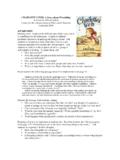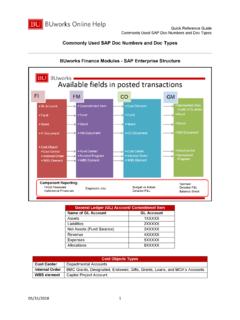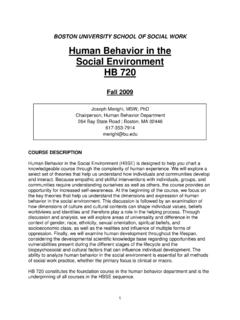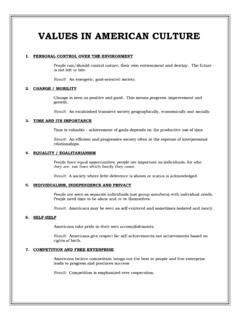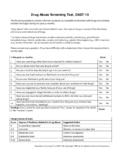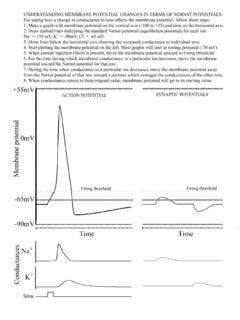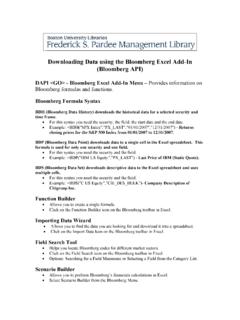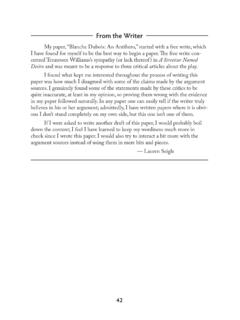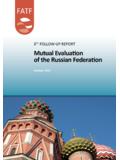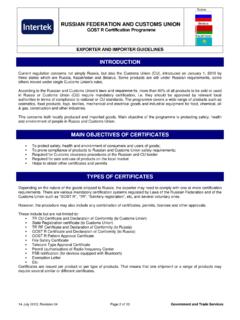Transcription of January 11, 2004 Boston, MA Vowel Reduction in …
1 LSA Annual Meeting 11, 2004 Boston, MA-1- Vowel Reduction in russian :The Categorical and the GradientJonathan BarnesBoston UniversityI. Introduction Phonological Vowel Reduction (hereafter VR): neutralization of Vowel quality contrasts inunstressed syllables. Figures in recent theoretical literature ( Barnes 2002, Beckman 1998, Crosswhite2001, Flemming 2oo1a and b, Steriade 1994) as an example of a pattern of PositionalNeutralization with relatively clear phonetic underpinnings. Understanding the relationship between these phonetic underpinnings and thephonological grammar in patterns such as VR is a central task of current work on thephonetics-phonology russian Vowel Facts Contemporary Standard russian : traditionally claimed to display two distinct patternsor degrees of VR, one for the syllable immediately preceding the tonic (here, firstpretonic), and one for all other unstressed syllables.
2 Five vowels contrast in stressed syllables1. Mid vowels do not surface in unstressed syllables.(1) Stressed Vowel inventoryfi1 pretonic s fi 2 pretonic, posttonic s i u i uiu e o a a Focus of this talk: /a/ vs. /o/ /a/ and /o/ contrast in stressed syllables, but this contrast is neutralized in unstressedsyllables as follows:(2) a. /a/, /o/ fi [a]/[ ] in first pretonic syllables, Degree 1 reductionb. /a/, /o/ fi [ ] in other unstressed syllables, Degree 2 Reduction 1 See Padgett 2001 and sources therein for arguments against a contrast between /i/ and the high central Vowel / /.
3 LSA Annual Meeting 11, 2004 Boston, MA-2-(3) VR in Contemporary Standard RussianSTRESSEDDEGREE 1 Reduction DEGREE 2 Reduction /o/mo@l d stJyouthmalo@dJInJkJIjyoung (dim.)m lado@jyoungbo@lJpainbalJe@tJto hurtb lJIvo@jpain (adj.)/a/sta@r jold (adj.)starJi@kold manst rJIna@old timesra@zumreasonrazu@mn wisely (adv.)r zumJe@tJto understand Several exceptions to the pattern described above are recognized:(4) No Reduction to schwa in absolute word-initial position/odno mu/[adna mu]'one' ( )*[ dna mu]/obi Zajet/[abJi Zajit]'insult, abuse' (3sg.)*[ bJi Zajit](5) No Reduction to schwa in hiatus before [a]/odnoo brazn j/ -> [adnaa brazn j]'monotonous' *[adn a brazn j]/sootno Senije/ -> [saatna SenJije] relationship *[s atna Senije](6) No Reduction to schwa in absolute phrase-final syllables (Matusevic& 1976: 102,Zlatoustova 1962: 109-139) Previous approaches Two recent OT (1995): Faithfulness constraints parameterized to the head foot ( thestressed syllable and first pretonic) rank higher than markedness constraints against[a] in unstressed syllables, which in turn outrank general Faithfulness (2001).
4 Vowels outside the head foot cannot bear moras, but [a] cannot benon-moraic, and so is realized as schwa. Both these approaches must present essentially diacritic solutions to the exceptionalpatterns described above. All previous accounts of VR in russian treat both Degree 1 and Degree 2 reductionpatterns as phonological, as changing phonological category membership throughmanipulation of distinctive feature Phonetic underpinnings of phonological Vowel Reduction Phonological patterns such as elimination of mid vowels and raising of low vowels inunstressed syllables have been claimed to have their source in the Reduction of phoneticvowel durations in unstressed Annual Meeting 11, 2004 Boston.
5 MA-3- Languages with phonological Vowel Reduction are almost invariably those languages witha stress accent strongly and reliably cued by a difference in Vowel duration betweenstressed and unstressed syllables (Lehiste 1970). Shortening of vowels in unstressed syllables leads to undershoot of more open targetarticulations of non-high vowels. Raising of these creates a compressed Vowel space inwhich contrasts are likely to be misperceived and to collapse over time (See Barnes 2002,Flemming 2001a for discussion). This accounts for the typological generalization that in VR systems, Vowel heightcontrasts are the first to go. When this happens, the vowels to go are almost invariablythe mid and low vowels.
6 High vowels stay One experiment, begetting Though phonological VR has clear phonetic roots diachronically in the shorterdurations associated with unstressed syllables in VR languages, to what extent phoneticduration is active in triggering Vowel Reduction synchronically is still poorly understood. The following experiment was designed to investigate this Methodology Experiment #1 was designed to determine what, if any, active role phonetic durationplays in the realization of Vowel Reduction in Reduction . Test words: 72 russian trisyllables12 stressed /a/ 12 stressed /o/12 1 pretonic /a/ 12 1 pretonic /o/12 2 pretonic /a/ 12 2 pretonic /o/ All target vowels were located in open syllables followed by unpalatalized voiced orvoiceless stops and preceded by unpalatalized voiced stops, voiceless stops, or laterals.
7 Tokens were embedded in frame sentences of the form Mashka X skazala, 'Mashka saidX'. Each token appeared twice for a total of 144 sentences. Sentences were randomized and arranged in blocks of 12. Subjects, one male from St. Petersburg, one female from Ufa, student-age nativespeakers of russian , were instructed to read through each block of sentences onceslowly and then once again as quickly as possible to achieve maximum variation in voweldurations. Sessions were recorded directly to CD at a sampling rate of KHz. Duration andLPC formant measurements were taken using Praat speech analysis software(Copyright@1992-2003 by Paul Boersma and David Weenink).LSA Annual Meeting 11, 2004 Boston, Mean values for duration and F1(7) Speaker 1 21 PRETONIC 2 PRETONICD uration 84 msF1553 Hz462 Hz(8) Speaker 2 STRESSED 1 PRETONIC2 PRETONIC/a//o//a, o//a, o/Duration 86 ms68 Hz466726 Hz492 Hz Neither speaker had any significant difference between unstressed /a/ and /o/ in anyposition.
8 This contrast is completely neutralized. Speaker 1 shows a mean F1 for 1 pretonic /a, o/ dramatically lower than a typical value forstressed /a/. Reflects traditional transcription of the former as [!] ( Matusevic 1972,Avanesov 1968). Probably more like [ ], see Barnes 2002, chapter 2, for details. For Speaker 2, no significant difference was found between F1 values for 1 pretonic /a, o/and stressed /a/. Vowel height as a function of phonetic duration The following displays the results of linear regression analyses of the relationshipbetween Vowel duration and Vowel height for Speakers 1 and 2 in Experiment 1.(9) Speaker 1a. R (92) = .179, p > .05b. R (60) = .602, p <.
9 0001 First Pretonic /a/ and /o/R2 = in ms. F1 in HzSeries1 Linear (Series1) 2 Speaker 1 in fact read a somewhat earlier version of the same experiment containing fewer words and not testingvowels in stressed Pretonic /a/ and /o/R2 = in ms. F1 in HzSeries1 Linear (Series1)LSA Annual Meeting 11, 2004 Boston, MA-5-Speaker 1: unstressed /a/ and /o/0100200300400500600700800020406080100 120 Duration in ms. F1 in HzSeries1 Series2(10) Speaker 2a. R (146) = .142, p > .05b. R (78) = .644, p <.0001 Speaker 2: unstressed /a/ and /o/0100200300400500600700800900100001020 30405060708090100 Duration in in HzSeries1 Series2 First Pretonic /a/ and /o/R2 = in ms.
10 F1 in HzSeries1 Linear (Series1)Second Pretonic /a/ and /o/R2 = in ms. F1 in HzSeries1 Linear (Series1)LSA Annual Meeting 11, 2004 Boston, Interim summary Neutralization of /a/ and /o/ in unstressed syllables is categorical. No significantdifference between these underlying categories is preserved. This is true regardless ofposition relative to stress. Reduction to schwa in Degree 2 Reduction environments has a clear gradient height is strongly dependent on Vowel duration. A cline of F1 values is recordedbetween more [a]-like values on longer vowels and more schwa-like values on shortervowels. Categorical vs. gradient application is argued to be a defining distinction betweensymbolic phonological processes and quantitative phonetic processes (see Keating1988c, Cohn 1990, Zsiga 1993, Myers 2000, Barnes 2002, inter alia) Hypothesis: given the duration-dependent cline of F1 values produced in Degree 2reduction contexts, there is no reason to think the phonology has any role in (or accessto) Reduction of unstressed /a, o/ to schwa.
